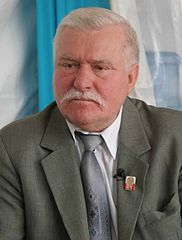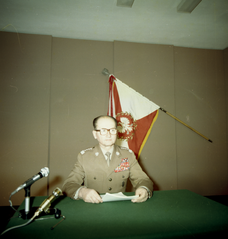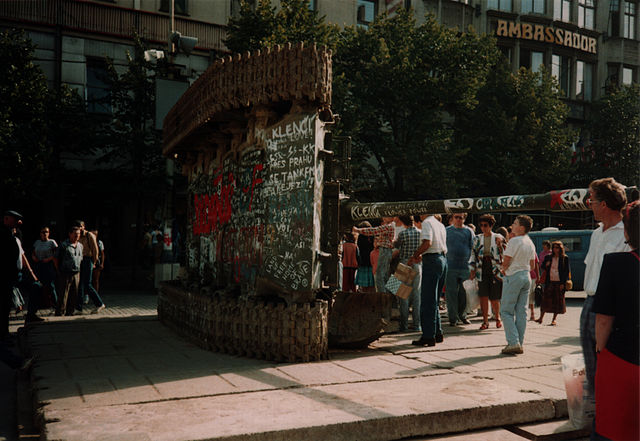On June 4, 1989, while most of the world’s eyes were trained towards the massacres erupting in Tiananmen Square, a less violent form of protest happened halfway around the world in Poland, one that would have been unthinkable merely a few years before. The Polish people enthusiastically and overwhelmingly voted the Polish United Workers Party (PZPR) out of power, awarding nearly all contestable seats in the Sejm (Parliament) and the newly-formed Senate to non-Communist candidates. The Polish elections laid the groundwork for other Eastern Bloc countries to forge ahead with their efforts to remove their Soviet-led communist parties from power, a process that would be fully realized in Eastern Europe by the end of the year.
 |
| Lech Wałęsa, 2009 |
The Polish elections were the culmination of nearly a decade of tireless work by the opposition, led by the labor union Solidarność (Solidarity) and its chairman, Lech Wałęsa. This period, from the PZPR’s declaration of marital law in December 1981 until the 1989 elections, is the subject of Gregory F. Domber’s book Empowering Revolution: America, Poland, and the End of the Cold War. Specifically, Domber tackles the question of who should claim primary responsibility for defrosting Cold War tensions in Poland—the Soviets, who were able to wield the threat of military intervention over the PZPR; the Americans, who used a system of economic carrots and sticks to incentivize a shift toward the West; or the Polish leadership themselves, whose authority was split between the PZPR, the opposition, and the Catholic church.
Domber argues that while American economic aid was an attractive and necessary source of support, the change in leadership in Poland came about because of domestic efforts, where local leaders “acted independently to seek individual solutions to unique problems” (281). Often frustrated at being used as a pawn between the United States and the Soviet Union, Poland resolutely decided to take charge of its own evolution.
 |
| General Wojciech Jaruzelski in 1981 |
When General Wojciech Jaruzelski declared martial law in 1981, it took the United States by surprise. In response, the United States imposed a system of sanctions meant to drive Poland immediately back into American arms; instead, the PZPR refused to give in, opting instead to forge ahead with their own political agenda without American support.
According to Domber, the effect of American sanctions was to damage relations between the two countries, which would take most of the ensuing decade, and the intervention of Wałęsa and Solidarność, to repair. Instead, Jaruzelski and the PZPR turned toward Western Europe for external financial support, a decision that yielded some aid, but not enough to fully supply the struggling country’s need.
Even when tensions were at the highest between the United States and the Polish government, American support for the Polish opposition and people never flagged. When the U.S. decided to start easing the sanctions, it was at the behest of the opposition and not in response to any substantial concessions by the Polish government to American demands. Although Wałęsa and Solidarność resisted direct financial assistance from foreign sources, the organization gladly accepted material donations to facilitate their underground publishing industry. Ink for samizdat printers was even smuggled into Poland in empty Hershey’s syrup containers in a case of rebellion disguised as luxury (73).
Humanitarian aid from civil and religious organizations in the West continued to flow into Poland. While sanctions were deemed necessary to keep pressure on the government, nobody wanted to see the Polish people starve. Meanwhile, informal and non-state actors worked to improve relations between the two nations, whether through salons in the residence of US chargé d’affaires John Davis or through the formidable religious network of the Catholic church (108). Sometimes these networks were more efficacious than sanctioned ones. For example, when the deal between Solidarność and the PZPR to elect Jaruzelski President in 1989 seemed to be in jeopardy, threatening to throw the whole power-sharing arrangement into chaos, Davis advised Solidarność leaders on how to throw an election while still maintaining a quorum in the Sejm (239).
Relations with Americans were not the only Polish concern. The rapidly shifting political situation in the Soviet Union meant Jaruzelski tried to pursue a domestic policy that would attempt to fix Poland’s rapidly deteriorating economic situation while worrying about a potential invasion by the Soviet Union and affiliated Warsaw Pact countries intended to keep Poland in line with broader Communist policy. The amount of leeway Jaruzelski had varied in relation to who occupied the General Secretary’s chair. It was only with Mikhail Gorbachev’s ascension in 1985 that Jaruzelski could pursue the type of liberalizing reforms Poland needed.
One of the strengths of Domber’s book is the attention he pays to Jaruzelski, a courtesy usually only given to Wałęsa and other opposition leaders. While it is never clear whether or not he was a true believer in communism, a picture of him emerges as neither Soviet shill nor American sycophant but rather a Polish politician first and foremost. Yet by the point where Jaruzelski’s reforms began to gain traction, it was a case of too little, too late.
 |
| The logo of Solidarność painted on an overturned Soviet era T-55 in Prague in 1990 |
The one significant downside of such a detailed look at foreign policy is that it risks aggrandizing the role of the leadership at the expense of the masses. The Polish people show up at the end of the book when they vote against—or decline to vote for in the case of the National Party lists—the Communist Party. Prior to that, however, Domber gives no hint that the general public had much bearing on foreign policy decisions besides as a group of mouths to feed. Due to the extent and size of protest activity in Poland, this perspective underestimates the impact of the Polish population as a whole on its revolutionary path.
In the end, the American policy of “empowering a segment of the indigenous opposition rather than forcing an American-led model of transformation” ended up being the appropriate choice for relations with Poland at the end of the Cold War (10). Domber suggests this might be an advantageous route to take in the future in order to further US interests abroad, and considering contemporary debates—of when to talk, when to intervene, when to sanction—it’s hard not to take the idea of letting the locals take the lead seriously.
